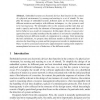Free Online Productivity Tools
i2Speak
i2Symbol
i2OCR
iTex2Img
iWeb2Print
iWeb2Shot
i2Type
iPdf2Split
iPdf2Merge
i2Bopomofo
i2Arabic
i2Style
i2Image
i2PDF
iLatex2Rtf
Sci2ools
BIRTHDAY
2008
Springer
2008
Springer
Approximating Behaviors in Embedded System Design
Embedded systems are electronic devices that function in the context of a physical environment, by sensing and reacting to a set of stimuli. To simplify the design of embedded systems, different parts are best described using different notations and analyze with different techniques, i.e., the system is said to be heterogeneous. We informally refer to the notation and the rules that are used to specify and verify the elements of heterogeneous systems and their collective behavior as a model of computation. In this paper, the use of conservative approximations (recently introduced by the authors) is reviewed to establish relationships between different models of computation in a design. After presenting the basic definitions, we propose three different models at different levels of abstraction for describing a system and the progression towards its implementation. Then, we derive associated conservative approximations starting from simple homomorphisms between sets of behaviors of the d...
Applied Computing | BIRTHDAY 2008 | Conservative Approximations | Electronic Devices | Embedded Systems |
| Added | 12 Oct 2010 |
| Updated | 12 Oct 2010 |
| Type | Conference |
| Year | 2008 |
| Where | BIRTHDAY |
| Authors | Roberto Passerone, Alberto L. Sangiovanni-Vincentelli |
Comments (0)

